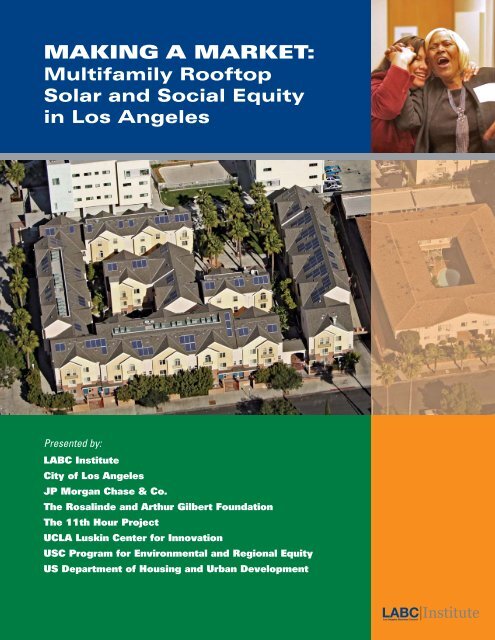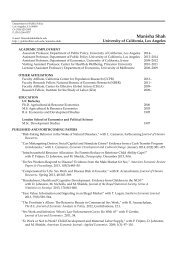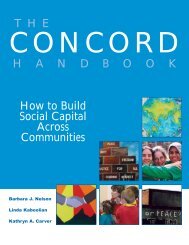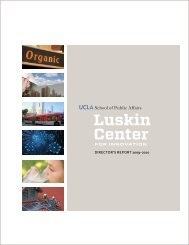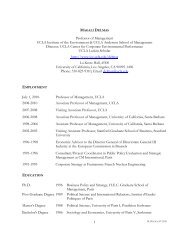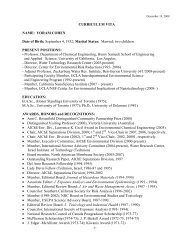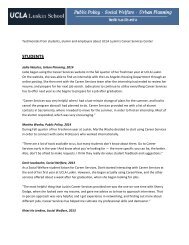Making a Market Executive Summary.pdf - UCLA Luskin School of ...
Making a Market Executive Summary.pdf - UCLA Luskin School of ...
Making a Market Executive Summary.pdf - UCLA Luskin School of ...
Create successful ePaper yourself
Turn your PDF publications into a flip-book with our unique Google optimized e-Paper software.
MAKING A MARKET:<br />
Multifamily Ro<strong>of</strong>top<br />
Solar and Social Equity<br />
in Los Angeles<br />
Presented by:<br />
LABC Institute<br />
City <strong>of</strong> Los Angeles<br />
JP Morgan Chase & Co.<br />
The Rosalinde and Arthur Gilbert Foundation<br />
The 11th Hour Project<br />
<strong>UCLA</strong> <strong>Luskin</strong> Center for Innovation<br />
USC Program for Environmental and Regional Equity<br />
US Department <strong>of</strong> Housing and Urban Development<br />
1
Acknowledgments<br />
The LABC Institute in collaboration with the Los Angeles Business Council (LABC) is<br />
pleased to present <strong>Making</strong> a <strong>Market</strong>: Multifamily Ro<strong>of</strong>top Solar and Social Equity<br />
in Los Angeles and gratefully acknowledges the 11 th Hour Project, The Rosalinde and<br />
Arthur Gilbert Foundation, JP Morgan Chase, and the US Department <strong>of</strong> Housing and<br />
Urban Development for generously underwriting this inaugural study.<br />
We would also like to thank the Los Angeles Housing Department for their contributions<br />
to this study. Finally, we thank the innovative organizations featured in this study for<br />
their considerable support <strong>of</strong> this project and vision in creating real solutions to meet<br />
our region’s housing needs and challenges.<br />
<strong>Making</strong> a <strong>Market</strong> Steering Committee<br />
Kelly Boyer<br />
Director, Multifamily HUB for Los Angeles, US Department <strong>of</strong> Housing and Urban Development<br />
Brad Cox<br />
Senior Managing Director, Trammell Crow Company; Chairman, LABC Institute<br />
JR DeShazo<br />
Director, <strong>UCLA</strong> <strong>Luskin</strong> Center for Innovation<br />
Doug Guthrie<br />
General Manager, Los Angeles Housing Department<br />
Mary Leslie<br />
President, LABC Institute<br />
Jacob Lipa<br />
President, PSOMAS; Chairman, LABC<br />
Antonio Manning<br />
Region <strong>Executive</strong>, JPMorgan Chase, Global Philanthropy - West/Southwest<br />
Ramon Mendez, Jr.<br />
Director <strong>of</strong> Solutions, Enterprise Community Partners, Inc.<br />
Manuel Pastor<br />
Director, USC Program for Environmental and Regional Equity<br />
Special thanks to the authors, JR DeShazo, Director, <strong>UCLA</strong> <strong>Luskin</strong> Center for Innovation;<br />
Manuel Pastor, Director, USC Program for Environmental and Regional Equity (USC<br />
PERE); Mirabai Auer, USC PERE; Vanessa Carter, USC PERE; Nicholas Vartanian,<br />
<strong>UCLA</strong> <strong>Luskin</strong> Center for Innovation. Thank you also to Jason Greenwald, Sugerman<br />
Communications Group; Adam Jacobson, Los Angeles Business Council; and Zarui<br />
Neksalyan, Los Angeles Business Council. All stakeholders contributed greatly in terms<br />
<strong>of</strong> thought and input to the final report; however, errors are sole property <strong>of</strong> the author.<br />
2
April 12, 2011<br />
Dear Business and Community Leaders:<br />
We are proud to release <strong>Making</strong> a <strong>Market</strong>: Multifamily Ro<strong>of</strong>top Solar and Social<br />
Equity in Los Angeles. This study builds on the LABC Institute’s efforts to create<br />
solutions to the jobs and affordable housing imbalance in the region.<br />
Last year, the Los Angeles Business Council (LABC) released the first <strong>of</strong> its solar studies,<br />
Designing an Effective Feed-in Tariff (FiT) for Greater Los Angeles, a program that<br />
would allow businesses, public and non-pr<strong>of</strong>it organizations, and residents to install<br />
solar panels on their ro<strong>of</strong>s and parking lots and sell the power generated back to the<br />
local utility. Participants would receive a payment back from the utility for each Kilowatthour<br />
fed back into the power grid. The CLEAN (Clean Local Energy Accessible Now) LA<br />
Solar Program (FiT) will generate a cost-effective source <strong>of</strong> renewable energy, create<br />
local jobs, and bring in revenue for businesses and ratepayers.<br />
The initial study identified a 1.4 GW potential for multifamily ro<strong>of</strong>top solar potential,<br />
which this study further investigates. To that end, today marks the release <strong>of</strong> <strong>Making</strong><br />
a <strong>Market</strong>, a major collaboration among the LABC Institute, USC Program for<br />
Environmental and Regional Equity, the <strong>UCLA</strong> <strong>Luskin</strong> Center for Innovation, U.S.<br />
Department <strong>of</strong> Housing and Urban Development and the City <strong>of</strong> Los Angeles. This study<br />
illustrates a vision <strong>of</strong> a new privately funded and publicly incentivized market for<br />
multifamily ro<strong>of</strong>top solar that reduces owner and tenant utility costs, provides a new<br />
revenue stream for owners, and creates and retains jobs for local workers.<br />
We would like to thank our underwriters, whose enthusiasm and commitment made this<br />
project possible, and the visionary leaders whose efforts serve as the basis for this<br />
study. We hope that this study sheds light onto an extraordinary program to help make<br />
Los Angeles more competitive, and create thriving communities throughout our region.<br />
Sincerely,<br />
Mary Leslie<br />
President<br />
LABC Institute<br />
Brad Cox<br />
Chairman<br />
LABC Institute<br />
William Vasquez<br />
Director<br />
Community Planning and Development<br />
U.S. Department <strong>of</strong> Housing and<br />
Urban Development<br />
3
<strong>Executive</strong> <strong>Summary</strong><br />
<strong>Making</strong> an Inclusive <strong>Market</strong>:<br />
Multi-family Ro<strong>of</strong>top Solar and Social Equity in Los Angeles<br />
Overview: Solar Power in the Land <strong>of</strong> Sunshine<br />
With President Obama's focus on clean energy investments and innovation, along with<br />
his efforts through the US Department <strong>of</strong> Housing and Urban Development (HUD) to<br />
build sustainable, affordable and energy-efficient communities, there has never been a<br />
better time for making a market for solar investments in affordable housing. According<br />
to HUD’s stated goals, the nation’s housing market needs to create and sustain a<br />
sufficient supply <strong>of</strong> affordable housing. Los Angeles is no different, and has the<br />
opportunity to lead the way for the nation.<br />
In the city known around the world as the home <strong>of</strong> dreams and sunshine, it stands to<br />
reason that a robust solar energy program would be part <strong>of</strong> the clean-energy solution<br />
for Los Angeles. Local policy-makers are now engaged in designing such a program,<br />
which would help realize California’s proposed new law to meet 33 percent renewable<br />
energy by 2020, <strong>of</strong> which 70 percent would need to be generated from California<br />
sources. With input from academic researchers, community and business leaders,<br />
environmental groups, neighborhood councils and other stakeholders, the City <strong>of</strong><br />
Los Angeles stands poised to enact a solar energy program that would bring clean,<br />
renewable energy to Angelenos at a reasonable cost. In fact, by providing incentives<br />
for homeowners and business-owners to install solar panels on their ro<strong>of</strong>s, the city<br />
would catalyze the creation <strong>of</strong> brand-new sources <strong>of</strong> clean energy that would play<br />
a role in weaning the city <strong>of</strong>f its reliance on polluting, coal-fired power plants.<br />
The purpose <strong>of</strong> this executive summary is to examine the way in which such a program<br />
can be broadened to enable more Angelenos to take part, adding to overall solar<br />
capacity and providing environmental and financial benefits as widely as possible.<br />
The final study will be completed in June 2011 and made available online at<br />
www.labusinesscouncil.org.<br />
Introduction: Solar FiT as a Policy Solution<br />
In response to Los Angeles City Mayor Antonio Villaraigosa’s call for over one gigawatt<br />
<strong>of</strong> solar development in the city, including a feed-in-tariff (FiT) program, researchers<br />
at <strong>UCLA</strong> and the Los Angeles Business Council have been working for over a year on<br />
design and policy recommendations for a solar FiT program. The economic benefits <strong>of</strong><br />
lower energy costs will be clearly evident to rate payers. However, incentives to retr<strong>of</strong>it<br />
are less obvious to residential and commercial property owners. Building owners would<br />
be incentivized to earn a reasonable rate <strong>of</strong> return on their investment; the utility would<br />
receive additional sources <strong>of</strong> clean, renewable energy, particularly during peak periods;<br />
and the city as a whole would benefit from a cost-effective program, as well as huge<br />
sums <strong>of</strong> private investment and thousands <strong>of</strong> local jobs that would be created.<br />
4
As a follow-up to two rigorous studies that examined the overall potential for a solar FiT<br />
in Los Angeles and specific design models that would be most effective, solar<br />
proponents sought to go a step further: to better understand the role <strong>of</strong> multi-family<br />
housing in creating a broad-based solar energy program. With this study, researchers<br />
from <strong>UCLA</strong> and USC seek to answer the following questions:<br />
How much solar capacity can multi-family housing contribute and what incentives must<br />
we create to encourage solar development?<br />
<br />
<br />
<br />
<br />
Who lives in multi-family housing?<br />
Would solar investment in multi-family housing occur in economically distressed<br />
neighborhoods?<br />
What policies would most effectively promote solar in multi-family housing?<br />
What are some <strong>of</strong> the barriers to success, and how can they be overcome?<br />
As it turns out, there is tremendous capacity for multi-family housing to contribute to a<br />
broader solar energy program. And many <strong>of</strong> the residents in multi-family housing are on<br />
the lower end <strong>of</strong> the income scale. In fact, many <strong>of</strong> the ro<strong>of</strong>tops with the greatest<br />
potential for solar power are found in economically depressed neighborhoods. And<br />
there are a number <strong>of</strong> policies that can effectively promote solar, by drawing on many<br />
<strong>of</strong> the same principles that would guide the broader solar program throughout the city.<br />
Creating a well-designed multi-family component <strong>of</strong> a solar program has the following<br />
benefits:<br />
It has the potential to create job opportunities and stabilize distressed neighborhoods<br />
It can reduce the costs <strong>of</strong> operating multi-family housing by reducing the costs <strong>of</strong> commonarea<br />
electricity and reduce or eliminate payments to utilities, allowing budget savings for<br />
tenant services.<br />
<br />
<br />
<br />
It can, if well-tailored, provide monetary benefits for low-income residents in the form <strong>of</strong><br />
rebates or reduced energy costs<br />
It gives Angelenos greater opportunity to choose to live in a more sustainable manner, with a<br />
reduced carbon footprint<br />
And it contributes to a larger pool <strong>of</strong> clean, renewable energy that can power homes and<br />
businesses throughout the city<br />
And these benefits contribute to the broader goals <strong>of</strong> a solar program for Los Angeles:<br />
supplying renewable energy at a reasonable cost, spurring private investment, creating<br />
thousands <strong>of</strong> new jobs, and reducing greenhouse gas emissions.<br />
How can a solar energy program be designed to ensure that lower-income Angelenos –<br />
many <strong>of</strong> whom live in multi-family housing – will have an opportunity to participate?<br />
What sorts <strong>of</strong> benefits could accrue to lower-income Angelenos? What are some <strong>of</strong> the<br />
barriers to success, and how can they be overcome? For answers to these questions<br />
and more, please read on.<br />
5
How much solar capacity can multi-family housing contribute and<br />
what incentives must we create to encourage solar development?<br />
Based on past studies, we know that one megawatt (MW) <strong>of</strong> solar capacity is roughly<br />
sufficient to <strong>of</strong>fset the energy needs <strong>of</strong> 100 homes. With that measurement in mind,<br />
we can look at the overall capacity that exists on ro<strong>of</strong>tops in Los Angeles. If it were<br />
technically and economically feasible to build solar panels on every available ro<strong>of</strong>top,<br />
the following totals could be generated:<br />
Commercial and Industrial:<br />
Single Family Homes:<br />
Multi-family Homes:<br />
Government/non-pr<strong>of</strong>it:<br />
TOTAL:<br />
2,218 MW<br />
1,752 MW<br />
1,411 MW<br />
156 MW<br />
5,537 MW<br />
It is important to note that these totals are strictly theoretical, as it is unlikely that solar<br />
panels will be installed on every Los Angeles ro<strong>of</strong>top in the near future. Yet they give a<br />
general sense <strong>of</strong> the total physical capacity for solar in the city. Roughly speaking, if<br />
every multi-family ro<strong>of</strong>top could be effectively covered with solar panels, they would<br />
have a capacity <strong>of</strong> 1.4 GW – sufficient to power 140,000 homes – or 8 percent <strong>of</strong> the<br />
city’s current energy needs.<br />
As it turns out, this capacity is spread throughout the city in a number <strong>of</strong> clusters <strong>of</strong><br />
great potential. As it turns out, there is physical potential <strong>of</strong> between 59 and 130 MW<br />
<strong>of</strong> solar on multi-family housing in each <strong>of</strong> the city’s 15 council districts. At least six <strong>of</strong><br />
these districts have capacities <strong>of</strong> between 75 and 100 MW, further indicating the even<br />
spread. The total number <strong>of</strong> multi-family sites is in excess <strong>of</strong> 100,000.<br />
So, which <strong>of</strong> these sites can most easily be developed? The first consideration is size<br />
and shape: large, flat ro<strong>of</strong>tops provide the most cost-effective solar power. Based on our<br />
analysis, the sites most ripe for development are those with a potential <strong>of</strong> 50 kW or more.<br />
There are approximately 4,000 buildings in the City <strong>of</strong> Los Angeles that fall into this<br />
category, with a potential capacity <strong>of</strong> more than 300 MW. Given the economies <strong>of</strong> scale<br />
and the number <strong>of</strong> large, flat ro<strong>of</strong>tops on multi-family buildings, this sector is likely to be the<br />
second most cost-effective market (after commercial and industrial) for solar in the city.<br />
In short, it will be easier and less expensive to harness significant quantities <strong>of</strong> solar<br />
power from multi-family ro<strong>of</strong>s than from single-family homes or smaller commercial<br />
ro<strong>of</strong>tops. Thus, it is a tremendous market that can bring very significant solar capacity<br />
to Los Angeles.<br />
6
We estimate that about 300 megawatts <strong>of</strong> multi-family capacity could be built if property<br />
owners were adequately incentivized with a payment equivalent to 24-26 cents per<br />
kilowatt-hour. This is based on paying owners a reasonable rate <strong>of</strong> return while at the<br />
same time ensuring that the cost <strong>of</strong> power is not prohibitively high. 300 MW would be<br />
a significant contribution to the city’s renewable energy portfolio, providing enough<br />
power to supply 30,000 homes <strong>of</strong> average size and need.<br />
Our analysis finds that 24 to 26 cents is sufficient to incentivize broad participation in<br />
the multi-family market, paying building owners a reasonable rate <strong>of</strong> return, while also<br />
enabling the other benefits <strong>of</strong> solar as outlined throughout this report. The price paid is<br />
based primarily on two factors: the cost <strong>of</strong> solar installation and the cost <strong>of</strong> obtaining<br />
financing. These may vary over time. At present, however, it is clear that a rate <strong>of</strong> 24 to<br />
26 cents per kilowatt-hour will generate sufficient participation and lead to the addition<br />
<strong>of</strong> 300 MW over the next five to 10 years.<br />
Further, a 300 MW program would produce over 4,500 direct and indirect job-years in<br />
local pr<strong>of</strong>essional services, construction, and ongoing system maintenance. Finally, it is<br />
worth noting that this payment can take either <strong>of</strong> two forms: a net-metering program,<br />
such as currently exists in the City <strong>of</strong> Los Angeles through the Solar Incentive Program,<br />
but with greater rates <strong>of</strong> return than are currently <strong>of</strong>fered; or a solar FiT, such as has<br />
been proposed and which policy-makers are currently considering.<br />
Who lives in multi-family housing?<br />
About 1.7 million people in Los Angeles<br />
live in multi-family housing – or, just<br />
under half <strong>of</strong> the city’s population.<br />
Of these, 94 percent are renters and<br />
6 percent are condo owners. While<br />
the households living in multi-family<br />
housing vary greatly, most are in middle<br />
and lower income brackets. The median<br />
household income in multi-family<br />
housing is about $36,000 per year,<br />
compared to a median household<br />
income <strong>of</strong> $71,800 for single<br />
family homes in the city.<br />
Among renters, the incomes<br />
are slightly lower. (See side chart.)<br />
Typically, as the number <strong>of</strong> units<br />
7
Case Study: Bonnie Brae Villages, Los Angeles, CA<br />
Bonnie Brae Village Apartments is a 92-unit community located<br />
in the Westlake neighborhood just west <strong>of</strong> downtown Los<br />
Angeles, and is an unusually complex project serving<br />
economically distressed seniors – more than 50 <strong>of</strong> whom are<br />
formerly homeless, and 40 <strong>of</strong> whom have<br />
mental illnesses.<br />
Despite some challenging financial<br />
issues while under development, Bonnie<br />
Brae is now thriving – and generating<br />
power from nearly 67 kW <strong>of</strong> solar panels<br />
on its ro<strong>of</strong>. Initial developer Enhanced<br />
Affordable Development made solar<br />
installations standard on its projects as<br />
early as 2004, recognizing the cost<br />
savings that could be generated by<br />
ro<strong>of</strong>top energy sources.<br />
The solar panels at Bonnie Brae <strong>of</strong>fset<br />
power usage from the common areas <strong>of</strong><br />
the building – community rooms, hallways, stairwells and the like<br />
– that could drop the overall cost <strong>of</strong> managing the building.<br />
Residents are already subsidized by the Housing Authority <strong>of</strong> the<br />
City <strong>of</strong> Los Angeles, which covers utility deposits, and U.S. HUD,<br />
which helps to reduce individuals’ energy costs.<br />
An electrical contractor handled design, engineering, installation<br />
and coordination with LADWP on financing, interconnection and<br />
billing. One third <strong>of</strong> the cost <strong>of</strong> installation – more than $150,000 –<br />
was paid directly to the contractor in the form <strong>of</strong> LADWP rebates.<br />
Bonnie Brae’s complex financing included loans from the city’s<br />
affordable housing trust fund and the state’s multi-family housing<br />
program, as well as bonds issued by the city. Affordable Living<br />
for the Aging, which assisted as the project moved toward<br />
completion, is in the process <strong>of</strong> taking over to become Bonnie<br />
Brae’s managing general partner.<br />
Bonnie Brae <strong>of</strong>fers its residents training and classes in areas<br />
such as money management, nutrition and cooking. Given what’s<br />
on the ro<strong>of</strong>top, it wouldn’t be far-fetched to add a seminar on<br />
sustainable living, too.<br />
in a residential building rises, the average<br />
income <strong>of</strong> families who live there falls. Further,<br />
these lower-income residents typically spend a<br />
greater percentage <strong>of</strong> their income on energy<br />
costs and rent. Among those who live in multifamily<br />
housing are a wide range <strong>of</strong> workers,<br />
including nurses, firefighters, police <strong>of</strong>ficers,<br />
landscapers and more. And those who live in<br />
affordable housing units are among society’s<br />
most vulnerable, including seniors, the poor,<br />
indigent and mentally ill.<br />
8
Would solar investment in multi-family housing occur<br />
in economically distressed neighborhoods?<br />
Given that the greatest solar potential lies with buildings that have large<br />
flat ro<strong>of</strong>s – which in the case <strong>of</strong> residential housing tends to be larger<br />
multi-family buildings – it is definitely the case in<br />
Los Angeles that many areas with high solar<br />
potential are also communities in economic need.<br />
Most <strong>of</strong> the solar potential as previously defined<br />
(50+ kW) exists in properties with five or more units.<br />
As has been noted, residents in these larger<br />
buildings tend to have lower incomes, particularly<br />
among renters. Given that many <strong>of</strong> the larger<br />
buildings are clustered together, there is great<br />
potential to install solar in neighborhoods with the<br />
greatest economic need.<br />
Put another way, many low-income renters<br />
currently live in or near high-density, high-solarpotential<br />
neighborhoods. In fact, an overlay <strong>of</strong> highsolar-potential<br />
areas and economically distressed<br />
neighborhoods shows a great deal <strong>of</strong> confluence.<br />
9
Case Study: Carlton Court Apartments, Hollywood, CA<br />
At the busy corner <strong>of</strong> Hollywood and Western, a steady stream <strong>of</strong><br />
transit riders emerge from the Metro station below. Amidst the<br />
honks and swerves <strong>of</strong> East Hollywood traffic, one just might notice<br />
Carlton Court Apartments – an affordable housing development that<br />
sits adjacent to the transit station.<br />
What can’t be seen from street level are the solar panels atop the<br />
Carlton Court Apartments – providing renewable energy to <strong>of</strong>fset<br />
the common load <strong>of</strong> the first phase <strong>of</strong> this 121-unit development, the<br />
city’s first attempt to create an affordable transit village. Developed<br />
by McCormack Baron Salazar (MBS) and Hollywood Community<br />
Housing Corporation (HCHC), Carlton Court Apartments houses<br />
more than 300 people, nearly half <strong>of</strong> whom have incomes <strong>of</strong> $10,000<br />
to $20,000. The decision by MBS to use solar is an example <strong>of</strong> a<br />
for-pr<strong>of</strong>it development company making a sustainable choice driven<br />
by both the common good and the bottom line.<br />
Through its in-house solar development and financing firm,<br />
Sunwheel Energy Partners, MBS has relied on a combination <strong>of</strong><br />
funding sources, including the federal New <strong>Market</strong>s Tax Credits<br />
program. With additional financial support from the federal Solar<br />
Incentives Tax Credit and local solar incentives, Sunwheel installed<br />
the solar panel system nearly 10 years after the property formally<br />
opened. The project took advantage <strong>of</strong> the California Solar Initiative<br />
program, currently slated to run through 2016, which provides<br />
generous rebates that make a solar retr<strong>of</strong>it financially palatable.<br />
As an LADWP customer, Carlton Court Apartments is eligible to<br />
<strong>of</strong>fset only the common-area load, and not the electricity that powers<br />
residential units. Based on our findings, the common area load for<br />
Carlton Courts represents solar energy savings <strong>of</strong> about $8,000<br />
annually. Still, the solar panels will help to provide a source <strong>of</strong> clean,<br />
renewable power and have proven to be a cost-effective investment<br />
for MBS. Although they can’t be seen from street level, those panels<br />
are showing the way to the future for multi-family development.<br />
The map Above identifies where both significant<br />
ro<strong>of</strong>top solar development potential and lowincome<br />
populations live. Our definitions are as<br />
follows: for the former, where there exists a<br />
cluster <strong>of</strong> three or more buildings with 50 kW <strong>of</strong><br />
potential and, for the latter, where greater than<br />
25 percent <strong>of</strong> the population lives below 150<br />
percent <strong>of</strong> the Federal Poverty Level. As shown<br />
10
Data sources: <strong>UCLA</strong> <strong>Luskin</strong> Center (Solar potential); City <strong>of</strong> Los Angeles (Parcel shapefile); U.S. Census (Tiger Line shapefiles, 2000; ACS, 2005-2009)<br />
in the map, shaded in red are those areas with both solar and equity potential, which<br />
emerge most strongly near Hollywood, Westlake and Koreatown, and across large<br />
sections <strong>of</strong> the San Fernando Valley. In green are those areas with high solar potential,<br />
but also more affluence.<br />
Thus, by targeting economically distressed areas with significant solar potential, a<br />
multi-family solar program can serve many low-income residents and, if properly<br />
designed, can also benefit those residents in a number <strong>of</strong> ways. The next section will<br />
address some <strong>of</strong> these benefits.<br />
11
What policies would most effectively promote solar in<br />
multi-family housing?<br />
From a policy perspective, the fundamental question is: How can the city effectively<br />
promote the development <strong>of</strong> solar capacity on multi-family ro<strong>of</strong>tops in Los Angeles?<br />
The question has been explored in depth in <strong>UCLA</strong>’s previous studies on the solar<br />
FiT, primarily examining the ways in which building owners can be appropriately<br />
incentivized to invest in solar panels, thus creating a new, renewable source <strong>of</strong> energy,<br />
while also ensuring that city ratepayers are protected from undue rate increases.<br />
In looking at multi-family housing, the key factors are the installation cost <strong>of</strong> solar<br />
panels; the rate paid to the building owner per kilowatt-hour generated; and the tax<br />
incentives available to subsidize the installation <strong>of</strong> panels. It is important to note that<br />
there are three distinct sectors within the multi-family category. Each has its own<br />
unique scenario, in terms <strong>of</strong> incentives and tax advantages, and therefore each<br />
requires different policy options. The three sectors are: small residential apartments<br />
(4 units or fewer), commercial rentals (5+ units) and condos.<br />
Fortunately, in the case <strong>of</strong> commercial rentals, which tend to have the most available<br />
ro<strong>of</strong>top space, there are generous incentives made available by the federal<br />
government. For apartments <strong>of</strong> 5 or more units, both an investment tax credit and<br />
standard depreciation would apply. These factors significantly defray the cost <strong>of</strong><br />
investment, and thus lower the rate that must be paid by the utility for energy.<br />
FiT (Feed-in Tariff); ITC (Investment Tax Credit); MACR<br />
(Modified Accelerated Cost Recovery System) depreciation credits<br />
12
Our analysis indicates that:<br />
<br />
<br />
<br />
<br />
Paying a rate <strong>of</strong> 24 to 26 cents per kilowatt-hour would be sufficient to attract a significant<br />
number <strong>of</strong> property owners.<br />
A 50 kW system installed at $4.50 per watt would produce an 7.6 percent return for the<br />
property owner, if the property owner is paid 25 cents per kWh.<br />
This rate could be in the form <strong>of</strong> a direct payment,<br />
as in the case <strong>of</strong> a FiT, or a combination <strong>of</strong><br />
payment and rebates, such as with net-metering.<br />
In fact, based on an analysis <strong>of</strong> expected demand,<br />
we estimate that 300 MW <strong>of</strong> capacity could be<br />
generated in the next 5 to 10 years.<br />
A well-designed multi-family solar program<br />
<strong>of</strong>fers numerous benefits to ratepayers and the<br />
general public alike. Such a program would:<br />
Contribute to a larger pool <strong>of</strong> clean, renewable<br />
energy for homes and businesses.<br />
<br />
<br />
<br />
<br />
A 300 MW program would produce over direct and<br />
indirect 4,500 job-years, based on the latest data.<br />
It can reduce the costs <strong>of</strong> operating multi-family<br />
housing by reducing the costs <strong>of</strong> common area<br />
electricity and reduce or eliminate payments to<br />
utilities, allowing budget savings for tenant services.<br />
Give more Angelenos the opportunity to live in a more sustainable manner with a<br />
reduced footprint.<br />
A 300 MW program could reduce about 6.7 million tons equivalent <strong>of</strong> CO2 by replacing<br />
coal and 1.1 million tons equivalent <strong>of</strong> CO2 by replacing natural gas. This is comparable<br />
to removing between 69,000 to 112,000 cars from the roads over ten years.<br />
13
The beauty <strong>of</strong> the solar<br />
panels is that they <strong>of</strong>fset<br />
our costs so much so<br />
that we pay nothing for<br />
utilities, allowing us to<br />
funnel those savings<br />
into our resident<br />
programs, providing<br />
computers, education<br />
programs and activities<br />
for the community.<br />
– Mary Silverstein, <strong>Executive</strong> Director,<br />
Los Angeles Housing Partnership (LAHP)<br />
in reference to LAHP’s Seven Maples<br />
Senior Housing Development<br />
What are some <strong>of</strong> the barriers to success, and how can<br />
they be overcome?<br />
As with any major policy undertaking, there are a number <strong>of</strong> potential barriers which<br />
must be examined to ensure that a program is well-designed and likely to succeed.<br />
The most significant barriers include the current lack <strong>of</strong> significant local incentives,<br />
as discussed above; the difficulty in channeling benefits directly to tenants; and the<br />
challenge <strong>of</strong> ensuring that job-creation benefits remain in the local community.<br />
A closer examination <strong>of</strong> each <strong>of</strong> these barriers follows:<br />
Barrier #1: Local solar incentives are declining,<br />
and there is currently no solar FiT in Los Angeles<br />
As noted above, an effective payment <strong>of</strong> 24-26 cents per<br />
kilowatt-hour will be necessary to adequately incentivize<br />
participation. This incentive can take the form <strong>of</strong> net metering<br />
(payment combined with rebate) or a FiT. Currently, net<br />
metering rebates are declining and the solar incentive program<br />
is oversubscribed, while a FiT has not yet been enacted.<br />
Policy makers can easily determine that the benefits <strong>of</strong> a robust<br />
incentive program <strong>of</strong>fset its modest costs, and that the solar FiT<br />
is an important policy solution for reasons outlined in this and<br />
previous studies. To enact these programs, they must prioritize<br />
solar and budget accordingly. As a result <strong>of</strong> our initial studies<br />
and the Mayor’s commitment, the LADWP has proposed a minimum <strong>of</strong> 150 MW <strong>of</strong> FiT in<br />
the 2011 Integrated Resources Plan.<br />
Barrier #2: It is difficult to channel benefits from a solar program<br />
directly to tenants<br />
While building owners will benefit directly from reduced energy costs (or direct<br />
payments, in the case <strong>of</strong> a FiT), there are no easy mechanisms to ensure that benefits<br />
flow through directly to tenants. We have discussed some <strong>of</strong> the ways in which these<br />
benefits can be passed on. One possibility would be to require that building owners<br />
participating in a solar energy program also participate in energy efficiency programs<br />
that would directly benefit residents in the form <strong>of</strong> rebates or reduced utility costs.<br />
These cost savings may eventually result in lower rent levels as well. For affordable<br />
housing units, where residents’ rent levels are <strong>of</strong>ten fixed, it may be possible to create<br />
an energy savings account to fund improvements to housing amenities and improved<br />
services for residents.<br />
Through the installation <strong>of</strong> solar panels on its ro<strong>of</strong>top, LA Housing Partnership’s (LAHP)<br />
Seven Maples, an affordable senior living development in MacArthur Park has <strong>of</strong>fset<br />
utility costs throughout the building, allowing costs savings to be directed to tenant<br />
services. Mary Silverstein, the <strong>Executive</strong> Director <strong>of</strong> LAHP states, “The beauty <strong>of</strong> the<br />
solar panels is that they <strong>of</strong>fset our costs so much so that we pay nothing for utilities,<br />
allowing us to funnel those savings into our resident programs, providing computers,<br />
education programs and activities for the community.”<br />
14
Barrier #3: It is a challenge to ensure that job creation<br />
benefits accrue to local residents, particularly in<br />
economically distressed areas<br />
A number <strong>of</strong> policy solutions could be implemented to ensure that the<br />
economic and employment benefits created by a solar energy program remain<br />
in the local area. A local labor requirement could ensure that work associated<br />
with installation goes to area businesses; DWP could use socioeconomic data<br />
to target its projects in economically distressed neighborhoods, as discussed<br />
earlier; and job training programs could be expanded in neighborhoods where<br />
multi-family solar installations are located.<br />
While this list <strong>of</strong> potential barriers and remedies is not exhaustive, it gives a sense<br />
<strong>of</strong> some <strong>of</strong> the major challenges and policy solutions available to city leaders.<br />
We believe that a thoughtful policy debate will lead to a well-crafted program<br />
with great benefit both to targeted neighborhoods and to the city as a whole.<br />
Conclusion<br />
With city leaders prepared to embark on a meaningful solar energy program,<br />
Los Angeles has the opportunity to ensure the broadest possible participation<br />
and benefits. By creating a robust multi-family component <strong>of</strong> the solar<br />
program, city leaders will serve many policy goals. Such a program would<br />
magnify the region’s solar-energy potential; contribute significantly to<br />
economic development in the form <strong>of</strong> investment and jobs, largely in<br />
distressed neighborhoods; and give lower-income Angelenos, many <strong>of</strong> whom<br />
do not have the same luxuries <strong>of</strong> choice as upper-income residents, the<br />
opportunity to participate in major environmental solutions.<br />
Our primary policy recommendation is that the City <strong>of</strong> Los Angeles create a FiT,<br />
or increase the net-metering program for multi-family buildings with an<br />
effective payment <strong>of</strong> 24 to 26 cents per kilowatt-hour that includes the<br />
following elements:<br />
An energy efficiency tie-in that would allow residents to benefit from rebates or<br />
reduced utility costs<br />
<br />
Local job-training programs that would enable more <strong>of</strong> these residents to be trained<br />
for the numerous manufacturing, installation and other jobs that will be created<br />
Through a well-designed program, city leaders can ensure that tangible<br />
benefits reach residents in the form <strong>of</strong> rebates, lower utility rates and possibly<br />
lower rent levels. In all, a robust multi-family component is a key part <strong>of</strong> a solar<br />
energy program for Los Angeles and stands to benefit many <strong>of</strong> its residents.<br />
L.A. Housing Department<br />
Gateway 2 Green<br />
Among the many ways in which L.A. is<br />
moving to achieve energy efficiency is a<br />
new program by the L.A. Housing<br />
Department (LAHD) called Gateway 2<br />
Green, which will allow existing LAHD<br />
inspectors to perform gateway energy<br />
assessments at all <strong>of</strong> the city’s 100,000<br />
multi-family rental properties on a<br />
continuing four-year cycle. This program<br />
will provide property owners with<br />
detailed information about their water<br />
and energy use in order to suggest<br />
retr<strong>of</strong>it work that conserves resources<br />
and lowers costs. As a result, the<br />
program will also create new jobs for<br />
energy and water efficiency assessment<br />
pr<strong>of</strong>essionals and construction trade<br />
workers.<br />
The LAHD anticipates the program will<br />
lead multi-family property owners to<br />
make significant investments to increase<br />
the efficiency <strong>of</strong> their buildings. After<br />
learning about their current energy and<br />
resource consumption and the potential<br />
savings <strong>of</strong>fered by improved efficiency,<br />
building owners are likely to invest in full<br />
building sustainability audits, building<br />
retr<strong>of</strong>its, and enhanced energy-saving<br />
and water-saving appliances.<br />
For more information, visit<br />
https://lahd.lacity.org/lahdinternet/.<br />
Photo Credits<br />
Cover Upper Right Side - Angela Means,<br />
Angela Means Photography<br />
Cover Large - Carlton Court. McCormack Baron Salazar<br />
Pages 8-9 - Bonnie Brae Villages. Angela Means,<br />
Angela Means Photography<br />
Page 10 - Carlton Court. McCormack Baron Salazar<br />
Page 13 - Carlton Court. Sunwheel Energy Partners<br />
Page 14 - Angela Means, Angela Means Photography<br />
15
2029 Century Park East<br />
Suite 1240<br />
Los Angeles, CA 90067<br />
310.226.7460<br />
Los Angeles Multifamily Hub<br />
611 W. Sixth Street, Suite 800<br />
Los Angeles, CA 90017<br />
213.894.8000<br />
www.labusinesscouncil.org<br />
16


